Analysis of Variation in Distance, Number, and Distribution of Spotting in Southeast Australian Wildfires
Abstract
1. Introduction
- How many spot fires are commonly produced in wildfires? How common is long-distance and mass spotting? What is the correlation between long-distance spotting and mass spotting (high numbers)?
- How are spot fires commonly distributed (mostly near or far)? Is there significant variation in spotting distributions?
- Is there significant geographic variation in spotting? Is it more common in some regions than others?
2. Materials and Methods
2.1. Study Location and Line Scans
2.2. Mapping Fires
2.3. Sampling and Analysis
- Exponential: Most spot fires within the first 250 m, decreasing numbers of spot fires in each bin out to the farthest spot fire and no gap > 1 km between any two spot fires (e.g., Appendix A, also the fires in Figure 2).
- Multi-modal: Like type 1, except with a gap >= 1 km between any two spot fires (e.g., Appendix A, also the fire in Figure 3).
- Other distribution: No prominent peak in the frequency plot, or the peak in spot fires was beyond the first 250 m bin (Appendix A).
3. Results
3.1. Spotting Distance Summary
3.2. Correlation between Spotting Measures (All Data Pooled)
3.3. Spot Fire Distance Distribution Types (All Regions Pooled)
3.4. Regional Spotting Distance and Number
3.5. Regional Spotting Distributions
3.6. Regional Environment
4. Discussion
4.1. Spot Distance and Number
4.2. Distributions
4.3. Regional Variation
5. Conclusions
Supplementary Materials
Author Contributions
Funding
Acknowledgments
Conflicts of Interest
Appendix A. Map Examples of Source Fire and Spot Fire Polygons of Each Spotting Distribution Type
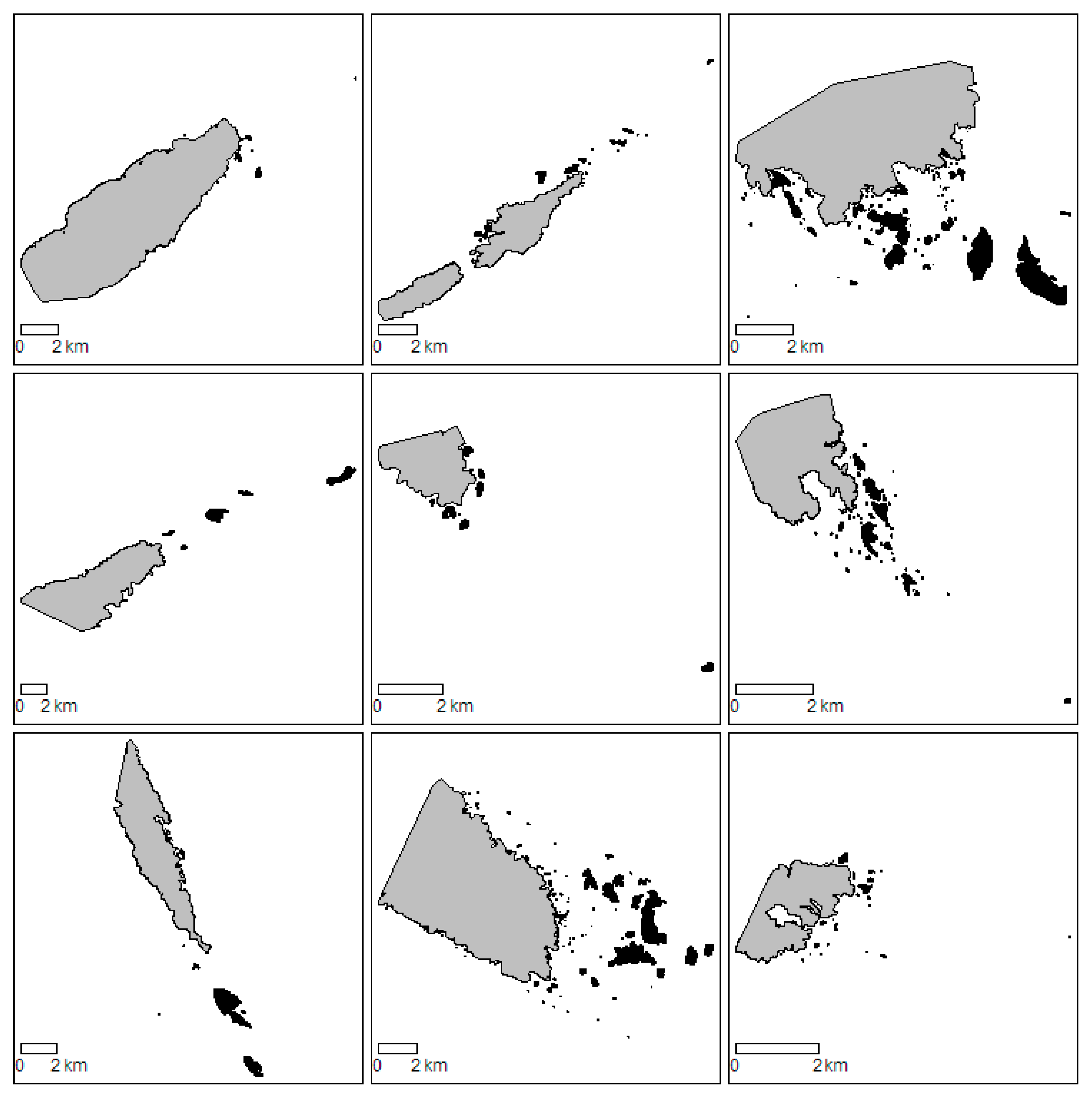
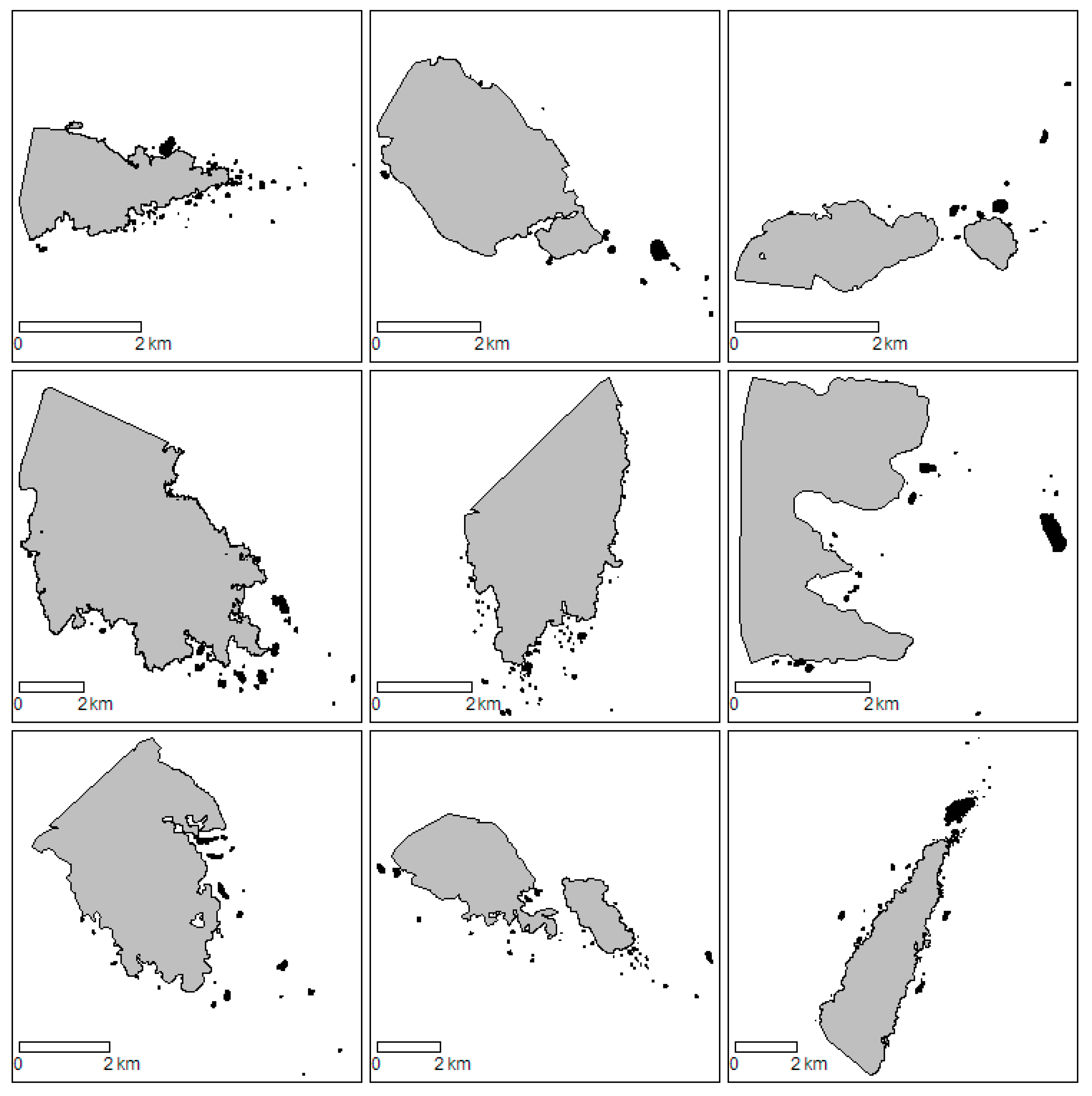
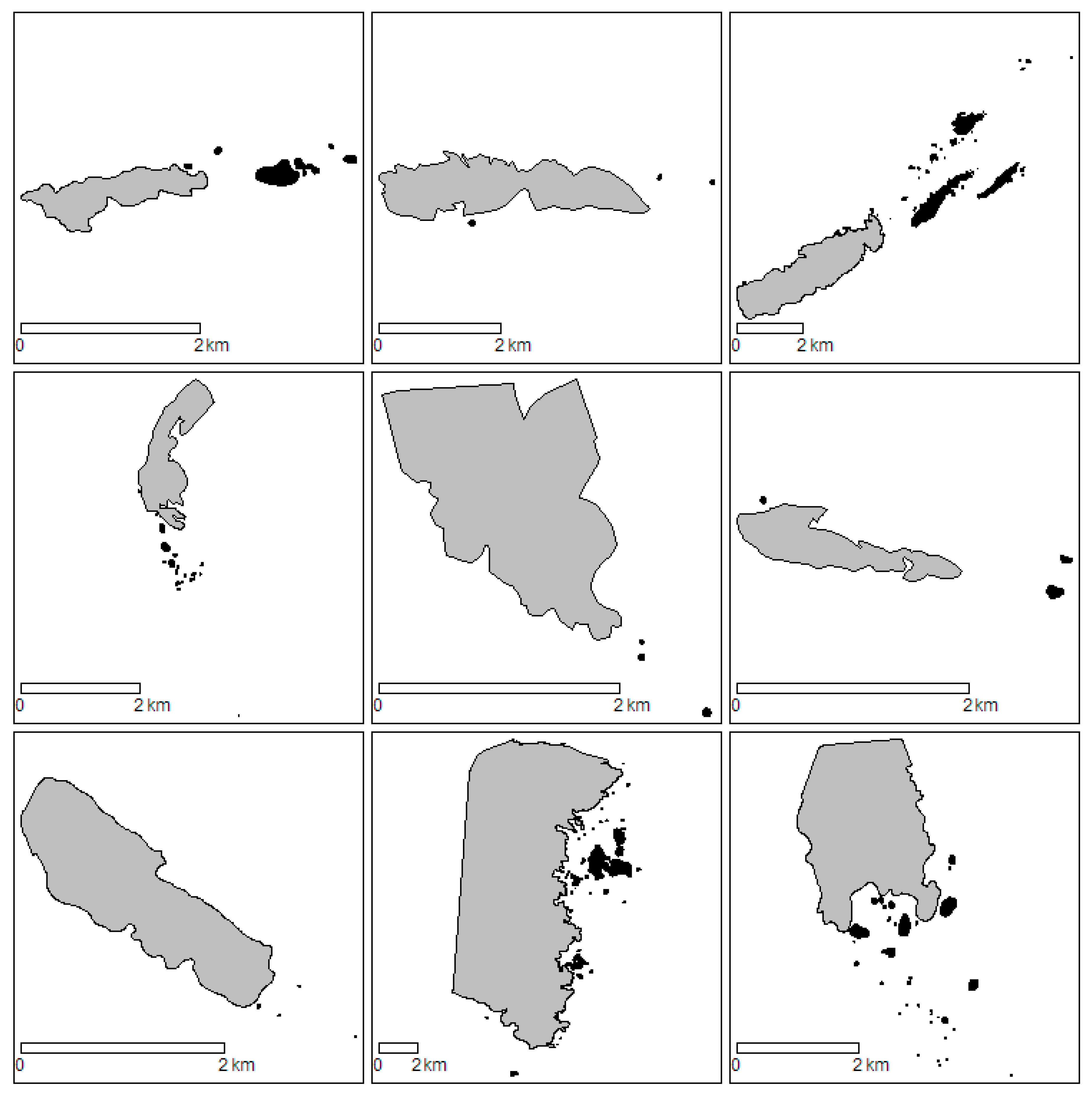
References
- Werth, P.A.; Potter, B.E.; Alexander, M.E.; Clements, C.B.; Cruz, M.G.; Finney, M.A.; Forthofer, J.M.; Goodrick, S.L.; Hoffman, C.; Jolly, W.M. Synthesis of knowledge of extreme fire behavior: Volume 2 for fire behavior specialists, researchers, and meteorologists. In General Technical Report PNW-GTR-891; US Department of Agriculture, Forest Service, Pacific Northwest Research Station: Portland, OR, USA, 2016; p. 258. [Google Scholar]
- Koo, E.; Pagni, P.J.; Weise, D.R.; Woycheese, J.P. Firebrands and spotting ignition in large-scale fires. Int. J. Wildland Fire 2010, 19, 818–843. [Google Scholar] [CrossRef]
- Storey, M.A.; Price, O.F.; Sharples, J.J.; Bradstock, R.A. Drivers of long-distance spotting during wildfires in south-eastern Australia. Int. J. Wildland Fire 2020. [Google Scholar] [CrossRef]
- Hall, J.; Ellis, P.F.; Cary, G.J.; Bishop, G.; Sullivan, A.L. Long-distance spotting potential of bark strips of a ribbon gum (Eucalyptus viminalis). Int. J. Wildland Fire 2015, 24, 1109–1117. [Google Scholar] [CrossRef]
- Ellis, P.F.M. Firebrand characteristics of the stringy bark of messmate (Eucalyptus obliqua) investigated using non-tethered samples. Int. J. Wildland Fire 2013, 22, 642–651. [Google Scholar] [CrossRef]
- Page, W.G.; Wagenbrenner, N.S.; Butler, B.W.; Blunck, D.L. An analysis of spotting distances during the 2017 fire season in the Northern Rockies, USA. Can. J. For. Res. 2018, 49, 317–325. [Google Scholar] [CrossRef]
- Albini, F.A.; Alexander, M.E.; Cruz, M.G. A mathematical model for predicting the maximum potential spotting distance from a crown fire. Int. J. Wildland Fire 2012, 21, 609–627. [Google Scholar] [CrossRef]
- Thurston, W.; Kepert, J.D.; Tory, K.J.; Fawcett, R.J.B. The contribution of turbulent plume dynamics to long-range spotting. Int. J. Wildland Fire 2017, 26, 317–330. [Google Scholar] [CrossRef]
- Martin, J.; Hillen, T. The Spotting Distribution of Wildfires. Appl. Sci. 2016, 6, 177. [Google Scholar] [CrossRef]
- Cruz, M.G.; Sullivan, A.L.; Gould, J.S.; Sims, N.C.; Bannister, A.J.; Hollis, J.J.; Hurley, R.J. Anatomy of a catastrophic wildfire: The Black Saturday Kilmore East fire in Victoria, Australia. For. Ecol. Manag. 2012, 284, 269–285. [Google Scholar] [CrossRef]
- Tedim, F.; Leone, V.; Amraoui, M.; Bouillon, C.; Coughlan, M.; Delogu, G.; Fernandes, P.; Ferreira, C.; McCaffrey, S.; McGee, T.; et al. Defining Extreme Wildfire Events: Difficulties, Challenges, and Impacts. Fire 2018, 1, 9. [Google Scholar] [CrossRef]
- Finney, M.A.; McAllister, S.S. A review of fire interactions and mass fires. J. Combust. 2011, 2011, 548328. [Google Scholar] [CrossRef]
- Toivanen, J.; Engel, C.B.; Reeder, M.J.; Lane, T.P.; Davies, L.; Webster, S.; Wales, S. Coupled Atmosphere-Fire Simulations of the Black Saturday Kilmore East Wildfires with the Unified Model. J. Adv. Model. Earth Syst. 2019, 11, 210–230. [Google Scholar] [CrossRef]
- Alexander, M.E.; Cruz, M.G. Evaluating a model for predicting active crown fire rate of spread using wildfire observations. Can. J. For. Res. 2006, 36, 3015–3028. [Google Scholar] [CrossRef]
- Rawson, R.P.; Billing, P.R.; Duncan, S.F. The 1982–83 forest fires in Victoria. Aust. For. 1983, 46, 163–172. [Google Scholar] [CrossRef]
- Luke, R.H.; McArthur, A.G. Bush Fires in Australia; Australian Government Publishing Service: Canberra, Australia, 1978; p. 359. [Google Scholar]
- Gould, J.S.; McCaw, W.; Cheney, N.; Ellis, P.; Knight, I.; Sullivan, A. Project Vesta: Fire in Dry Eucalypt Forest: Fuel Structure, Fuel Dynamics and Fire Behaviour; CSIRO Publishing: Canberra, Australia, 2008. [Google Scholar]
- McCaw, W.L.; Gould, J.S.; Phillip Cheney, N.; Ellis, P.F.M.; Anderson, W.R. Changes in behaviour of fire in dry eucalypt forest as fuel increases with age. For. Ecol. Manag. 2012, 271, 170–181. [Google Scholar] [CrossRef]
- Sardoy, N.; Consalvi, J.L.; Kaiss, A.; Fernandez-Pello, A.C.; Porterie, B. Numerical study of ground-level distribution of firebrands generated by line fires. Combust. Flame 2008, 154, 478–488. [Google Scholar] [CrossRef]
- Koo, E.; Linn, R.R.; Pagni, P.J.; Edminster, C.B. Modelling firebrand transport in wildfires using HIGRAD/FIRETEC. Int. J. Wildland Fire 2012, 21, 396–417. [Google Scholar] [CrossRef]
- Wang, H.-H. Analysis on Downwind Distribution of Firebrands Sourced from a Wildland Fire. Fire Technol. 2009, 47, 321–340. [Google Scholar] [CrossRef]
- Pereira, J.; Pereira, J.; Leite, A.; Albuquerque, D. Calculation of Spotting Particles Maximum Distance in Idealised Forest Fire Scenarios. J. Combust. 2015, 2015, 17. [Google Scholar] [CrossRef]
- Song, J.; Huang, X.; Liu, N.; Li, H.; Zhang, L. The Wind Effect on the Transport and Burning of Firebrands. Fire Technol. 2017, 53, 1555–1568. [Google Scholar] [CrossRef]
- Tohidi, A.; Kaye, N.B. Stochastic modeling of firebrand shower scenarios. Fire Saf. J. 2017, 91, 91–102. [Google Scholar] [CrossRef]
- Zhou, K.; Suzuki, S.; Manzello, S.L. Experimental Study of Firebrand Transport. Fire Technol. 2015, 51, 785–799. [Google Scholar] [CrossRef]
- Wadhwani, R.; Sutherland, D.; Ooi, A.; Moinuddin, K.; Thorpe, G. Verification of a Lagrangian particle model for short-range firebrand transport. Fire Saf. J. 2017, 91, 776–783. [Google Scholar] [CrossRef]
- Tohidi, A.; Kaye, N.B. Comprehensive wind tunnel experiments of lofting and downwind transport of non-combusting rod-like model firebrands during firebrand shower scenarios. Fire Saf. J. 2017, 90, 95–111. [Google Scholar] [CrossRef]
- Teague, B. 2009 Victorian Bushfires Royal Commission - Final Report; Parliament of Victoria: Melbourne, Australia, 2010. [Google Scholar]
- McLeod, R. The Inquiry into the Operational Response to the January 2003 Bushfires; Australia Capital Territory Government: Canberra, Australia, 2003.
- Dillon, H. Inquiry into Fire at Wambelong Camp Ground, Warrumbungles National Park, New South Wales January 2013; Coroner’s Court of NSW: Sydney, Australia, 2015.
- Sharples, J.J.; Cary, G.J.; Fox-Hughes, P.; Mooney, S.; Evans, J.P.; Fletcher, M.-S.; Fromm, M.; Grierson, P.F.; McRae, R.; Baker, P. Natural hazards in Australia: Extreme bushfire. Clim. Chang. 2016, 139, 85–99. [Google Scholar] [CrossRef]
- Cheney, N.; Bary, G. The propagation of mass conflagrations in a standing eucalypt forest by the spotting process. In Mass Fire Symposium; Defense Standards Laboratory: Melbourne, Australia, 1969; pp. 10–12. [Google Scholar]
- Matthews, A.G. FIRESCAN: A Technique for Airborne Infra-Red Mapping of Wild Fires. Ph.D. Thesis, Monash University, Melbourne, Australia, 1997. [Google Scholar]
- Cook, R.; Walker, A.; Wilkes, S. Airborne Fire Intelligence. In Innovations in Remote Sensing and Photogrammetry; Jones, S., Reinke, K., Eds.; Springer: Berlin/Heidelberg, Germany, 2009; pp. 239–253. [Google Scholar] [CrossRef]
- Sharples, J.J.; McRae, R.H.; Wilkes, S.R. Wind–terrain effects on the propagation of wildfires in rugged terrain: Fire channelling. Int. J. Wildland Fire 2012, 21, 282–296. [Google Scholar] [CrossRef]
- Geoscience Australia. Geoscience Australia, 1 Second SRTM Digital Elevation Model (DEM). Available online: http://data.bioregionalassessments.gov.au/dataset/9a9284b6-eb45-4a13-97d0-91bf25f1187b (accessed on 30 June 2016).
- Simard, M.; Pinto, N.; Fisher, J.B.; Baccini, A. Mapping forest canopy height globally with spaceborne lidar. J. Geophys. Res. Biogeosci. 2011, 116. [Google Scholar] [CrossRef]
- BOM. Mean Monthly and Mean Annual Rainfall Data (Base Climatological Data Sets). Available online: http://www.bom.gov.au/jsp/ncc/climate_averages/rainfall/index.jsp (accessed on 1 October 2018).
- Bhutia, S.; Ann Jenkins, M.; Sun, R. Comparison of Firebrand Propagation Prediction by a Plume Model and a Coupled–Fire/Atmosphere Large–Eddy Simulator. J. Adv. Model. Earth Syst. 2010, 2. [Google Scholar] [CrossRef]
- Keith, D. Ocean Shores to Desert Dunes: The Native Vegetation of New South. Wales and the ACT; New South Wales Government-Environment Protection Authority: Sydney, Australia, 2004.
- Hollander, M.; Wolfe, D.A.; Chicken, E. Nonparametric Statistical Methods; John Wiley & Sons: Hoboken, NJ, USA, 2013; Volume 751. [Google Scholar]
- Noble, I.R.; Gill, A.M.; Bary, G.A.V. McArthur’s fire-danger meters expressed as equations. Aust. J. Ecol. 1980, 5, 201–203. [Google Scholar] [CrossRef]
- Woycheese, J.P.; Pagni, P.J.; Liepmann, D. Brand Propagation from Large-Scale Fires. J. Fire Prot. Eng. 1999, 10, 32–44. [Google Scholar] [CrossRef]
- Albini, F.A. Spot Fire Distance from Burning Trees: A Predictive Model; Intermountain Forest and Range Experiment Station, Forest Service, U.S. Dept. of Agriculture: Ogden, UT, USA, 1979; p. 73.
- Anand, C.; Shotorban, B.; Mahalingam, S. Dispersion and deposition of firebrands in a turbulent boundary layer. Int. J. Multiph. Flow 2018, 109, 98–113. [Google Scholar] [CrossRef]
- McArthur, A.G. Fire Behaviour in Eucalypt Forests; Department of National Development Forestry and Timber Bureau: Canberra, Australia, 1967; Volume 107, p. 36.
- Sharples, J.J. An overview of mountain meteorological effects relevant to fire behaviour and bushfire risk. Int. J. Wildland Fire 2009, 18, 737–754. [Google Scholar] [CrossRef]
- Bradstock, R.A. A biogeographic model of fire regimes in Australia: Current and future implications. Glob. Ecol. Biogeogr. 2010, 19, 145–158. [Google Scholar] [CrossRef]
- McRae, R.; Sharples, J.; Fromm, M. Linking local wildfire dynamics to pyroCb development. Nat. Hazards Earth Syst. Sci. 2015, 15, 417–428. [Google Scholar] [CrossRef]
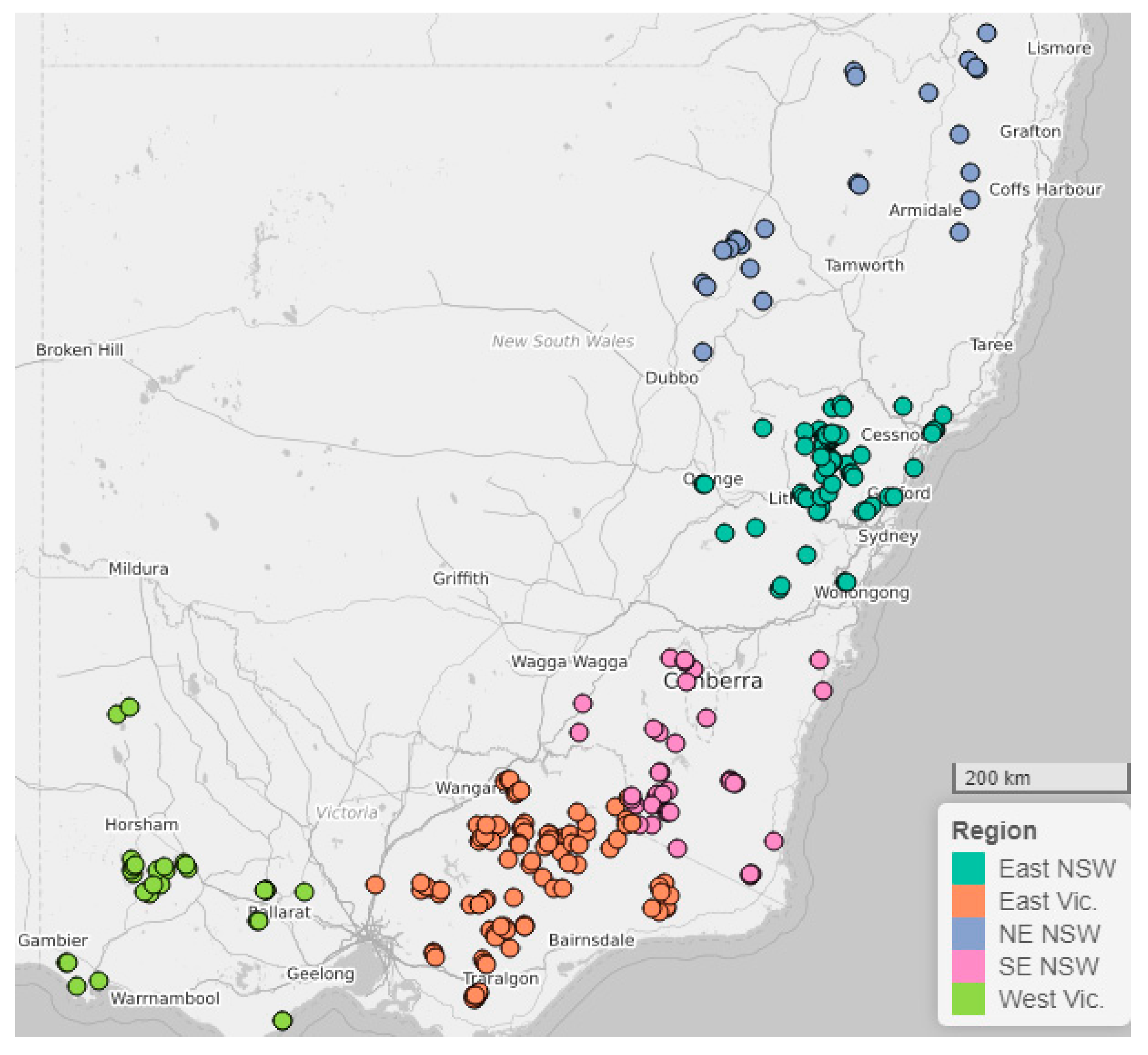
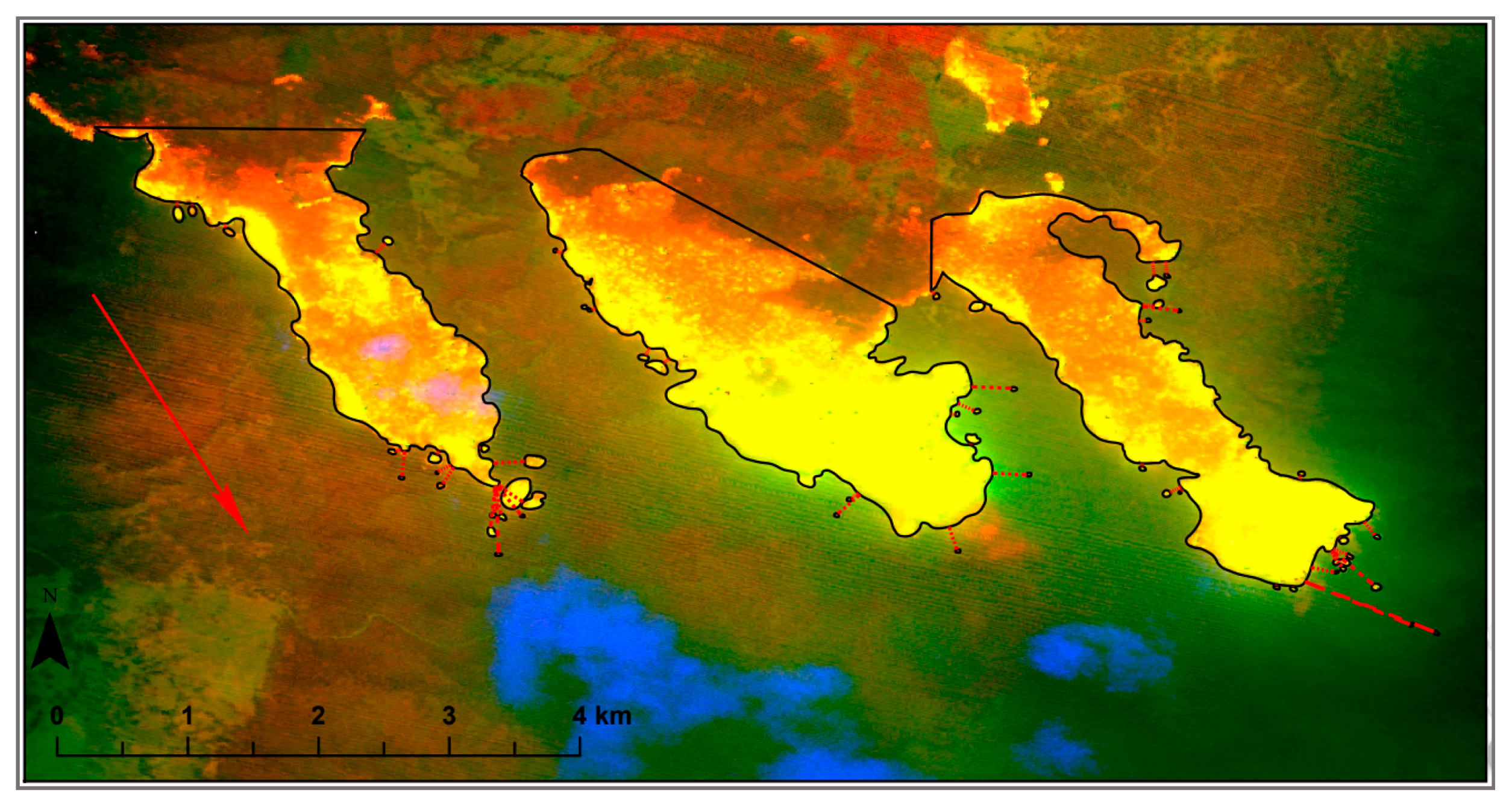
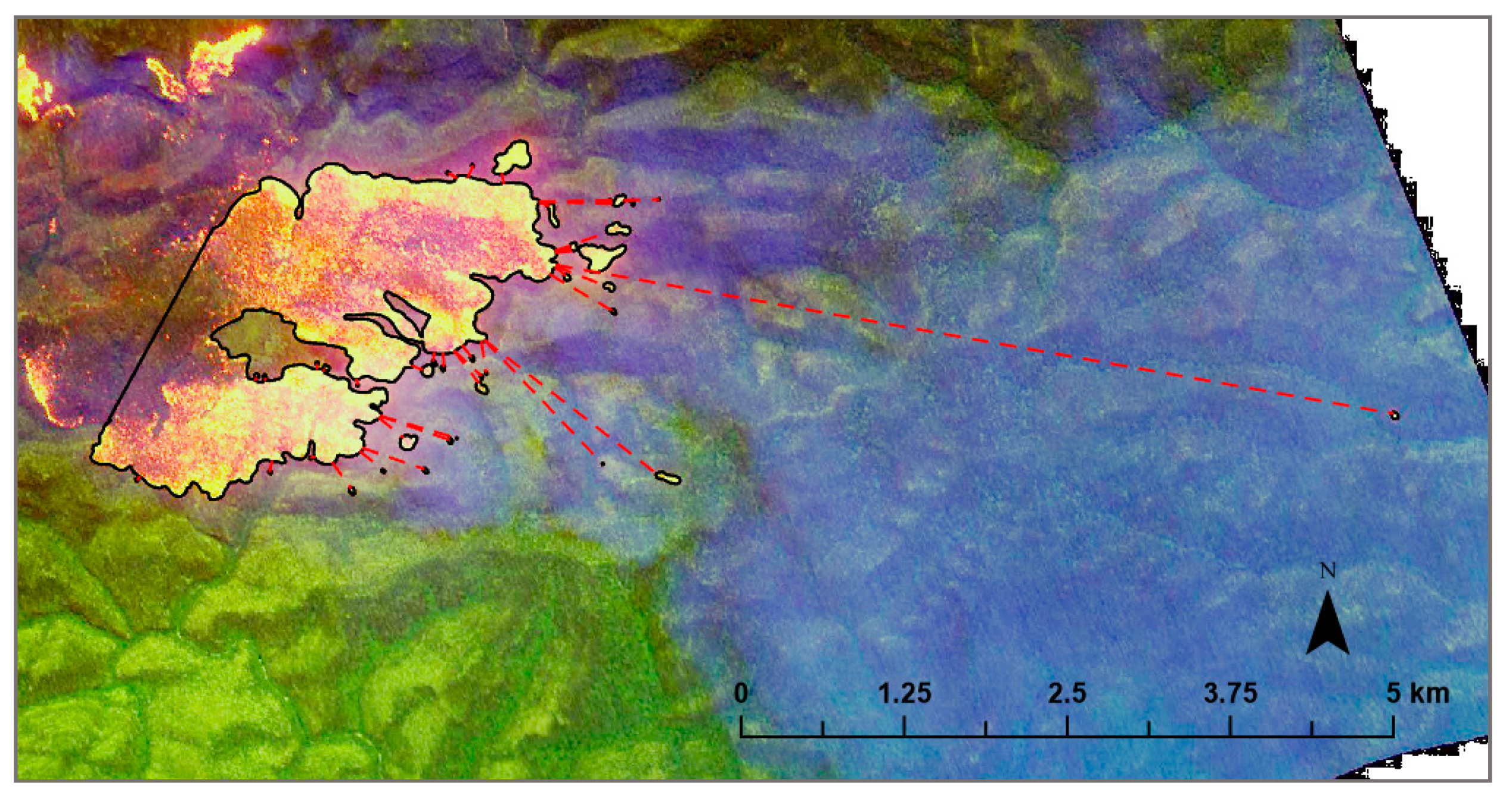
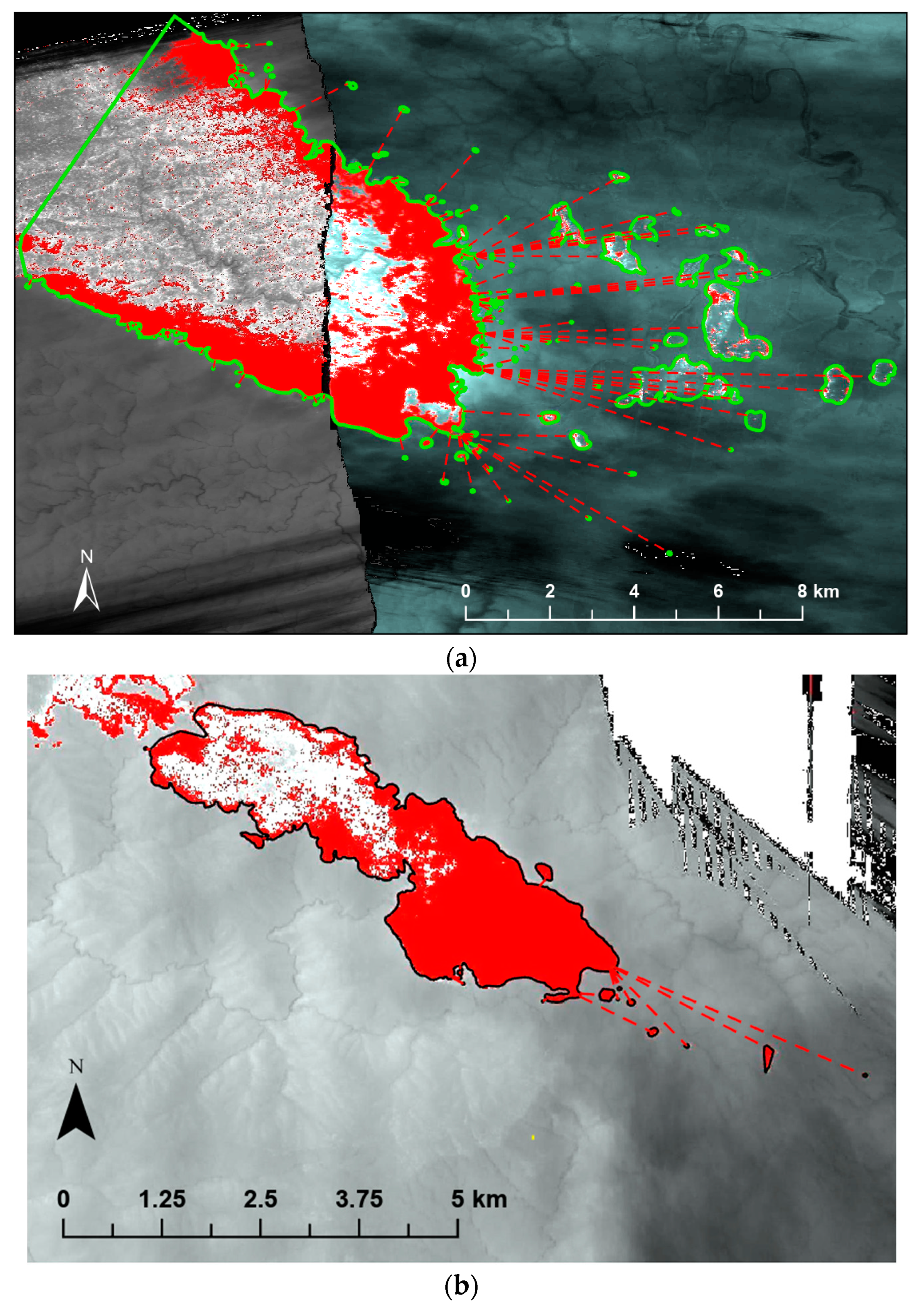
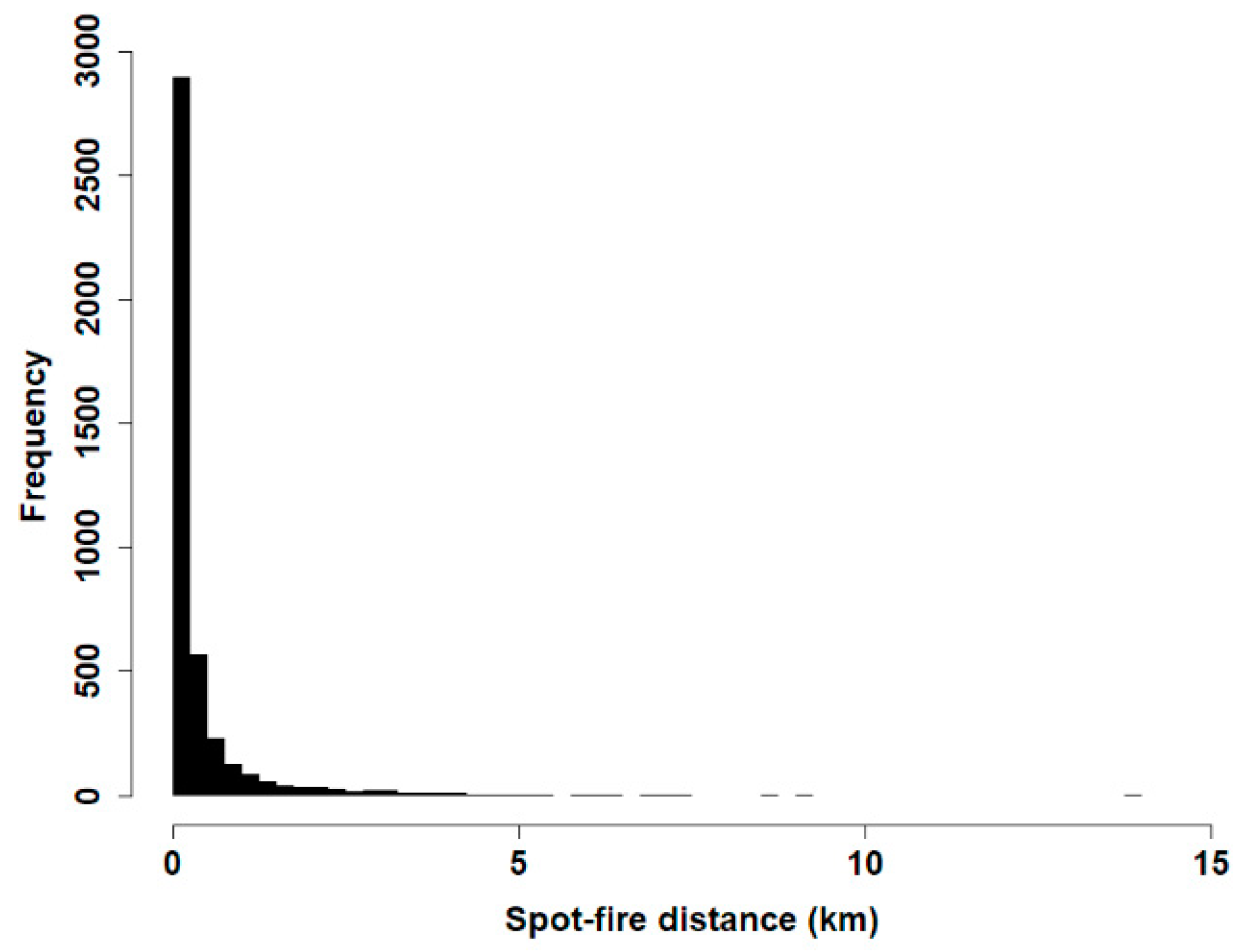
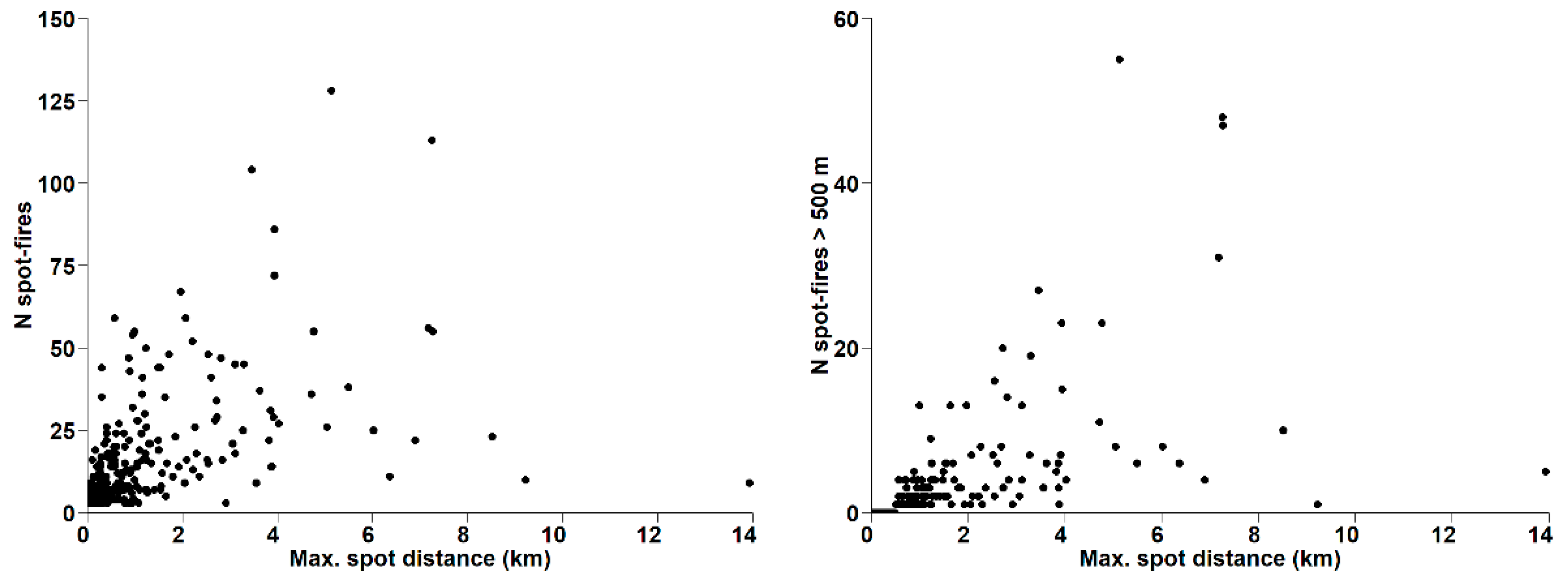
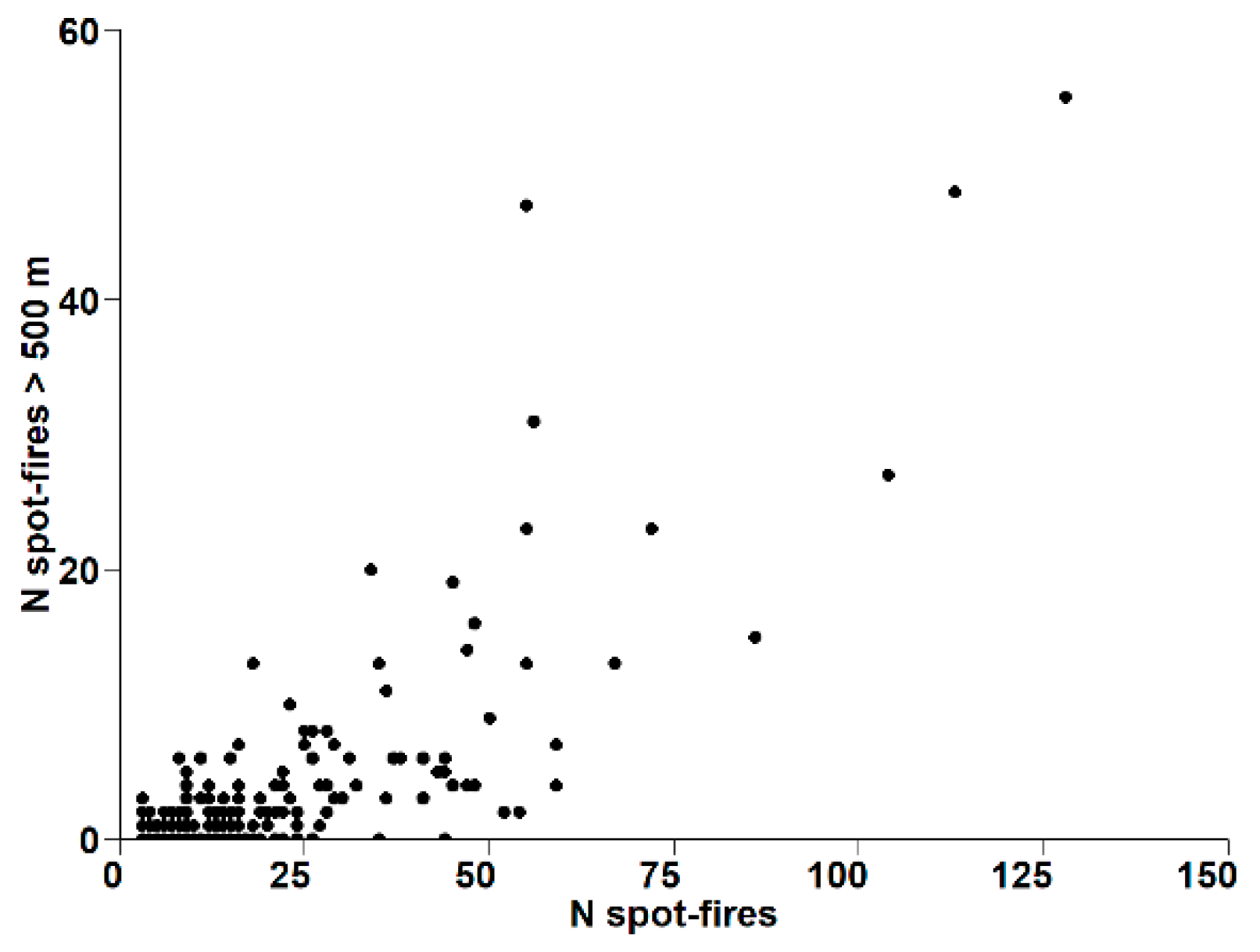

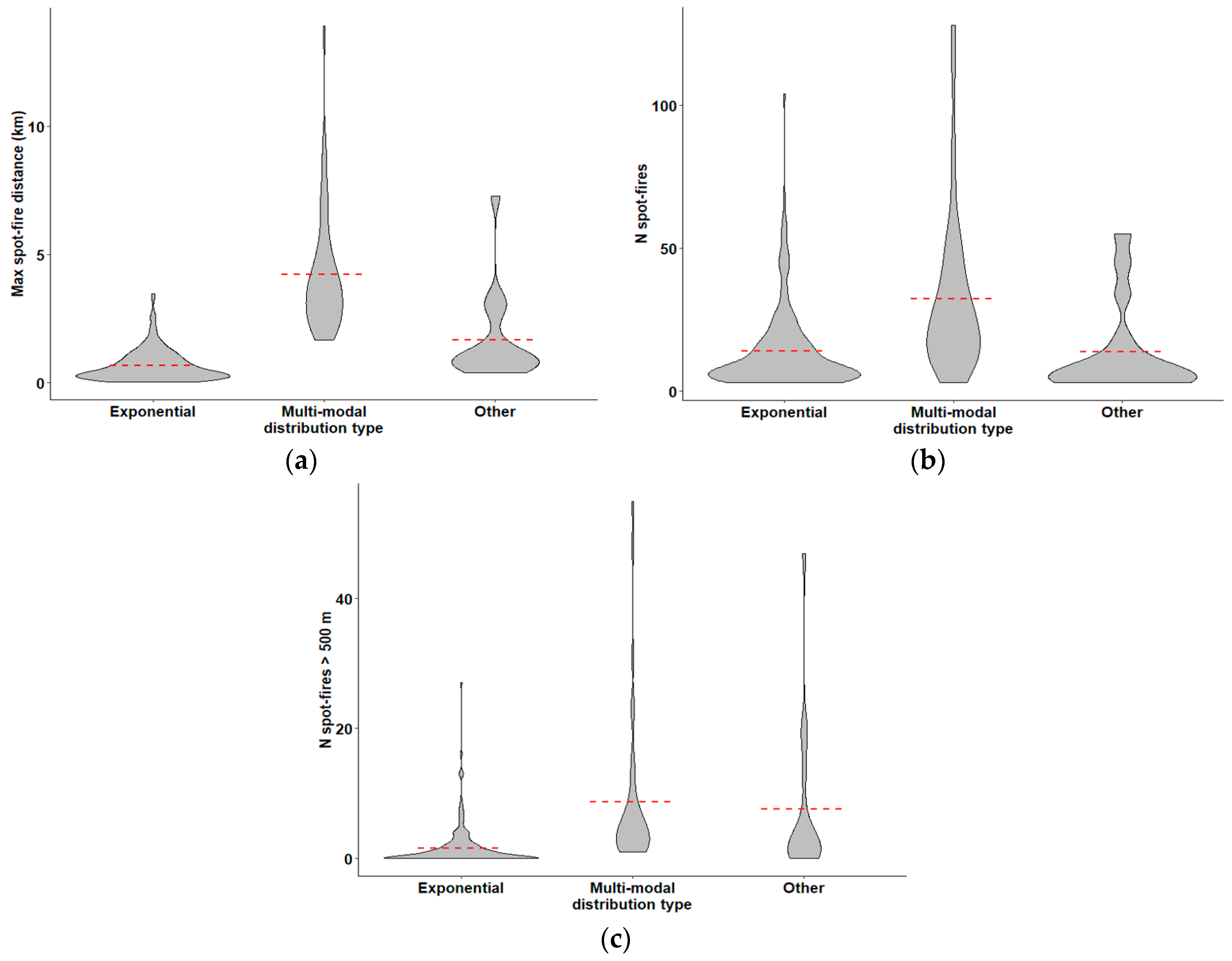




| Multi-Modal | Exponential | Other | |
|---|---|---|---|
| N spots: Mean (median) | 32.2 (23) | 14 (8) | 13.8 (7.5) |
| N spots: Min–max | 3–128 | 3–104 | 3–55 |
| N spots > 500 m: Mean (median) | 8.7 (4) | 1.5 (0) | 7.6 (2) |
| N spots > 500 m: Min–max | 1–55 | 0–27 | 0–47 |
| Max distance km: Mean (median) | 4.3 (3.8) | 0.6 (0.4) | 1.6 (0.9) |
| Max distance km: Min–max | 1.65–13.9 | 0.02–3.5 | 0.36–7.3 |
| East NSW | East Vic. | NE NSW | SE NSW | West Vic. | |
|---|---|---|---|---|---|
| N spots: Mean (median) | 14 (8) | 20.1 (13.5) | 8.3 (6.5) | 22 (17) | 13.1 (8) |
| N spots: Min–max | 3–86 | 3–128 | 3–26 | 3–104 | 3–47 |
| N spots > 500 m: Mean (median) | 1.7 (1) | 5.1 (1) | 0.5 (0) | 3.6 (2) | 0.9 (0) |
| N spots > 500 m: Min–max | 0–15 | 0–55 | 0–8 | 0–27 | 0–4 |
| Max distance km: Mean (median) | 1 (0.6) | 1.8 (0.9) | 0.4 (0.3) | 1.6 (0.9) | 0.7 (0.3) |
| Max distance: Min–max | 0.08–9.2 | 0.06–8.5 | 0.02–2.3 | 0.04–13.9 | 0.02–4 |
| Multi-Modal | Exp. | Other | |
|---|---|---|---|
| East Vic. | 25.5% | 64.9% | 9.6% |
| SE NSW | 18.9% | 81.1% | 0.0% |
| East NSW | 9.1% | 81.8% | 9.1% |
| West Vic. | 6.7% | 93.3% | 0.0% |
| NE NSW | 0.0% | 95.8% | 4.2% |
© 2020 by the authors. Licensee MDPI, Basel, Switzerland. This article is an open access article distributed under the terms and conditions of the Creative Commons Attribution (CC BY) license (http://creativecommons.org/licenses/by/4.0/).
Share and Cite
Storey, M.A.; Price, O.F.; Bradstock, R.A.; Sharples, J.J. Analysis of Variation in Distance, Number, and Distribution of Spotting in Southeast Australian Wildfires. Fire 2020, 3, 10. https://doi.org/10.3390/fire3020010
Storey MA, Price OF, Bradstock RA, Sharples JJ. Analysis of Variation in Distance, Number, and Distribution of Spotting in Southeast Australian Wildfires. Fire. 2020; 3(2):10. https://doi.org/10.3390/fire3020010
Chicago/Turabian StyleStorey, Michael A., Owen F. Price, Ross A. Bradstock, and Jason J. Sharples. 2020. "Analysis of Variation in Distance, Number, and Distribution of Spotting in Southeast Australian Wildfires" Fire 3, no. 2: 10. https://doi.org/10.3390/fire3020010
APA StyleStorey, M. A., Price, O. F., Bradstock, R. A., & Sharples, J. J. (2020). Analysis of Variation in Distance, Number, and Distribution of Spotting in Southeast Australian Wildfires. Fire, 3(2), 10. https://doi.org/10.3390/fire3020010







